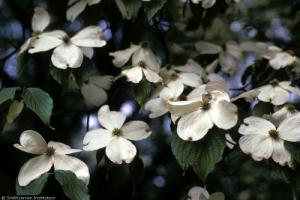Due to its hard, strong, heavy, fine-grained, and shock-resistant wood, Cornus florida was used for shuttles in textile manufacturing, and is used for tool handles, and tool parts. It is also used for golf clubs, roller-skate wheels, knitting needles, and similar items. In addition, it is a very valuable species for wildlife; all parts of the plant are used as food by various animals (the fruits are poisonous to humans, but not to animals).
Photo Credit: © R.A. Howard, USDA-NRCS PLANTS Database. Courtesy of Smithsonian Institution, Dept. of Systematic Biology, Botany.
Cornus florida
Common Name: flowering dogwood
Plant Functional Group: Deciduous broadleaf
Class > Order > Family: Magnoliopsida > Cornales > Cornaceae
What does the species look like?
Flowering dogwood is a deciduous, multi-trunked, shrub to small tree growing 10 to 55 feet tall. Its tiny, yellow flowers are inconspicuous, and have both male and female parts. The flowers are clustered in the center and surrounded by four large, white or pinkish bracts that look like petals, rendering it very showy. Flowering occurs when plants mature at about 6 years of age, and are insect-pollinated.
Flowering dogwood favors well-drained, light upland soils to deep, moist soils. It is often found in mesic deciduous woods, on floodplains, lower to middle slopes, and bluffs, in ravines, and along streams. It is very shade tolerant, and is reportedly sensitive to drought and flooding.
Where is the species found?
States & Provinces
AL, AR, CT, DC, DE, FL, GA, IL, IN, KS, KY, LA, MA, MD, ME, MI, MO, MS, NC, NH, NJ, NY, OH, OK, ON, PA, RI, SC, TN, TX, VA, VT, WV
Special Considerations for Observing
If drought seems to be the cause of leaf color or fall for a plant, please make a comment about it for that observation.
Which phenophases should I observe?
Do you see...?
Leaves
Breaking leaf buds More...
How many buds are breaking?
Less than 3 3 to 10 11 to 100 101 to 1,000 1,001 to 10,000 More than 10,000
Leaves More...
What percentage of the potential canopy space is full with leaves? Ignore dead branches in your estimate of potential canopy space.
Less than 5% 5-24% 25-49% 50-74% 75-94% 95% or more
Increasing leaf size More...
What percentage of full size are most leaves?
Less than 25% 25-49% 50-74% 75-94% 95% or more
Colored leaves Cornus florida , ignore the red color that leaves growing in full sun develop in the spring or summer. This red pigment develops to protect the leaves from the sun and does not indicate the leaf is dying (senescing).More...
What percentage of the potential canopy space is full with non-green leaf color? Ignore dead branches in your estimate of potential canopy space.
Less than 5% 5-24% 25-49% 50-74% 75-94% 95% or more
Falling leaves More...
Flowers
Flowers or flower buds More...
How many flowers and flower buds are present? For species in which individual flowers are clustered in flower heads, spikes or catkins (inflorescences), simply estimate the number of flower heads, spikes or catkins and not the number of individual flowers.
Less than 3 3 to 10 11 to 100 101 to 1,000 1,001 to 10,000 More than 10,000
Open flowers Cornus florida , ignore the four large, white bracts and watch for the opening of the small flowers in the center of the bracts.More...
What percentage of all fresh flowers (buds plus unopened plus open) on the plant are open? For species in which individual flowers are clustered in flower heads, spikes or catkins (inflorescences), estimate the percentage of all individual flowers that are open.
Less than 5% 5-24% 25-49% 50-74% 75-94% 95% or more
Fruits
Fruits Cornus florida , the fruit is berry-like and changes from green to bright red.More...
How many fruits are present?
Less than 3 3 to 10 11 to 100 101 to 1,000 1,001 to 10,000 More than 10,000
Ripe fruits
View Phenophase Image Cornus florida , a fruit is considered ripe when it has turned bright red.More...
What percentage of all fruits (unripe plus ripe) on the plant are ripe?
Less than 5% 5-24% 25-49% 50-74% 75-94% 95% or more
Recent fruit or seed drop More...
How many mature fruits have dropped seeds or have completely dropped or been removed from the plant since your last visit?
Less than 3 3 to 10 11 to 100 101 to 1,000 1,001 to 10,000 More than 10,000
What do these phenophases look like?
There is currently no photoguide available for this species. If you'd like help us create one, use the guidance document and species template provided here . Then send it via email to education@usanpn.org when it is complete.
